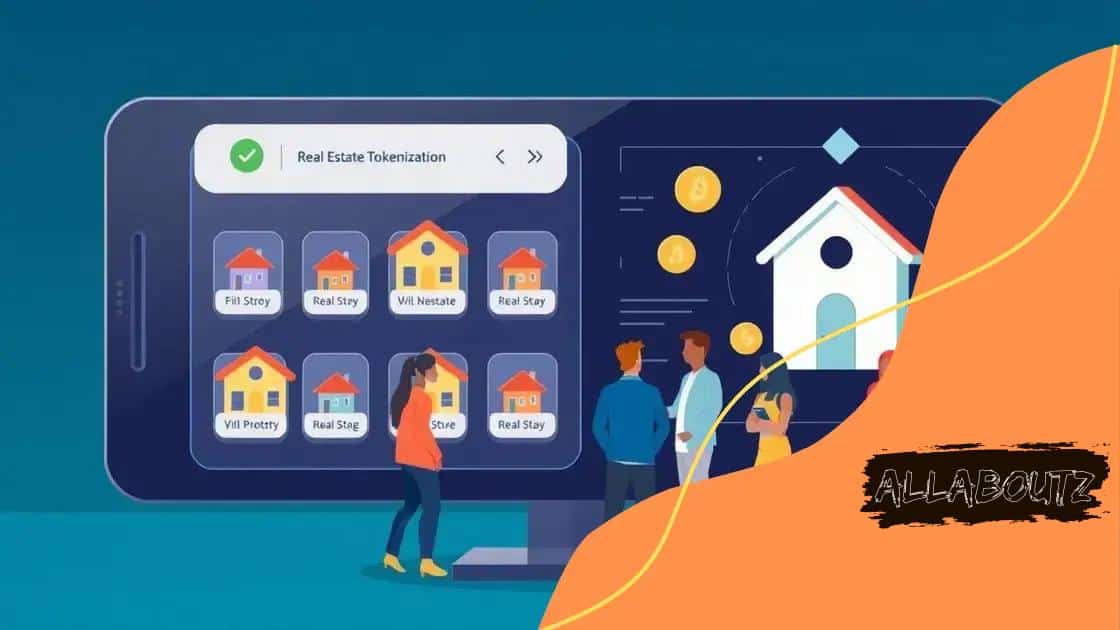Real estate tokenization and fractional ownership made easy

Real estate tokenization and fractional ownership allow multiple investors to share ownership of properties, enhancing liquidity, lowering investment barriers, and providing transparent transactions in the evolving real estate market.
Real estate tokenization and fractional ownership are changing the landscape of property investment. Imagine taking part in a high-value real estate market without needing a fortune. Let’s dive into what this means for you.
Understanding real estate tokenization
Understanding real estate tokenization is vital for modern investors. This innovative approach merges technology with real estate, opening new doors in property investment.
Tokenization involves converting property rights into digital tokens, which are recorded on a blockchain. This means investors can own fractions of real estate without directly purchasing whole properties. For many, this accessibility is a game changer.
How Tokenization Works
The process of tokenization is straightforward. First, a property is evaluated, and its worth is calculated. Next, the property is divided into digital tokens that represent shares of ownership.
Key Benefits
- Increased liquidity: Investors can buy or sell their tokens easily.
- Lower minimum investment: Tokenization allows investors to enter the market with smaller amounts of capital.
- Transparency: Blockchain technology ensures that all transactions are traceable, providing security and trust.
Another aspect of real estate tokenization is the potential for diversification. With tokens, investors can spread their funds across multiple properties, reducing risk. Unlike traditional investing, where high costs limit options, tokenization democratizes access to real estate opportunities.
As the real estate industry adopts this method, more people can invest in lucrative markets that were once exclusive. Innovations in technology continue to reshape the future, enabling more individuals to participate in real estate.
In summary, understanding real estate tokenization is crucial for anyone looking to invest. It combines finance and technology to create greater opportunities for the average investor.
How fractional ownership works
Understanding how fractional ownership works is essential for anyone interested in the modern real estate market. This innovative investment model allows multiple individuals to share ownership of a single property.
Fractional ownership means that instead of one person buying a whole property, several investors purchase shares. Each investor holds a percentage of the property, which gives them rights to a portion of the income generated and usage of the property.
Process of Fractional Ownership
The process starts with identifying a property that will be offered for fractional ownership. Once the property is selected, it is divided into shares that are sold to interested buyers. Each share entitles the owner to a specific amount of time spent at the property or a portion of the rental income.
Key Features
- Shared Costs: Maintenance, taxes, and insurance costs are divided among all owners, making it more affordable.
- Reduced Investment Risk: Investing in fractions minimizes individual financial exposure.
- Access to High-Value Properties: Investors can participate in luxury real estate options without bearing the full cost.
This model is particularly appealing in vacation real estate, where several individuals can enjoy the property at different times. Unlike traditional partnerships, fractional ownership offers better legal protections and an organized structure that allows for seamless management of the property.
As more people learn about fractional ownership, the demand for these investment opportunities is expected to grow. The appeal lies in the combination of accessibility and the ability to generate passive income.
Benefits of tokenization in real estate

The benefits of tokenization in real estate are transforming how investors engage with the market. This innovative approach allows for a more inclusive and flexible investment landscape.
One of the primary advantages is increased liquidity. Traditional real estate investments often require significant capital and a long-term commitment. With tokenization, properties can be divided into smaller shares, making it easier to buy and sell ownership stakes.
Key Advantages
- Lower Barriers to Entry: Investors can enter the property market with smaller amounts of money.
- Flexibility: Tokenized assets can be easily traded or diversified across various properties.
- Enhanced Transparency: Transactions are recorded on a blockchain, providing a secure and traceable history of ownership.
Another significant benefit is the potential for fractional ownership. This means that more individuals can participate in high-value properties that would typically be out of reach. By owning a fraction of a property, investors can enjoy rental income and appreciation without the burden of full ownership.
Furthermore, tokenization maximizes efficiency in transactions. The use of smart contracts automates processes, reducing the need for intermediaries and therefore cutting costs. This efficiency not only benefits investors but also simplifies the management of properties.
As the real estate market evolves, embracing tokenization can lead to new opportunities, making real estate investing more accessible and profitable for individuals everywhere.
Challenges and risks of fractional ownership
Understanding the challenges and risks of fractional ownership is essential for potential investors. While this investment model offers various benefits, it also comes with unique risks that you should consider before jumping in.
One main challenge is managing the shared responsibility among owners. Decisions regarding the property can sometimes lead to conflicts, especially if the owners have different expectations. Clear agreements outlining responsibilities and usage schedules can help mitigate these issues.
Common Risks to Consider
- Reduced Control: As an owner, you may have limited decision-making power, which can be frustrating.
- Market Volatility: The value of the property can fluctuate, affecting your investment’s worth.
- Legal Complications: Navigating the legal aspects of shared ownership can be complex and may require legal assistance.
Another risk involves potential changes in property management. If the entity managing the property does not perform well, it can lead to dissatisfaction among owners. This makes it essential to choose a reputable management company.
Moreover, the market for fractional ownership is still evolving. Depending on the location and type of property, resale options for your fractional share may be limited. This can make it challenging to cash out if needed.
Additionally, regular expenses such as maintenance, utilities, and property taxes need to be shared. If one owner fails to pay their share, it can create financial strain on others. It’s crucial to have agreements in place to address these issues proactively.
The future of real estate investment
The future of real estate investment is poised for significant changes driven by innovation and technology. Emerging trends are reshaping how people buy, sell, and manage properties.
One key trend is the increasing reliance on digital platforms. These platforms streamline the buying process, making it easier for investors to find opportunities without the need for extensive research. As technology advances, expect even more sophisticated tools that analyze market data and property values.
Innovative Investment Models
The rise of tokenization is another trend changing the landscape. By converting properties into digital tokens, investors can participate in real estate markets with lower barriers to entry. This model not only democratizes access but also enhances liquidity, allowing for quicker buying and selling of shares.
Shifts in Consumer Preferences
- Increased Demand for Flexibility: Investors are looking for properties that offer more than just passive income. They want options that allow for personal use as well.
- Sustainable Investments: There is a growing preference for eco-friendly properties. Green buildings are becoming more appealing due to their lower environmental impact.
- Remote Work Influence: The rise of remote work is influencing where people choose to live, impacting real estate values in urban and suburban areas.
Technological advancements, such as virtual reality and blockchain, will also play critical roles. Virtual reality offers potential buyers immersive property tours, while blockchain technology ensures secure and transparent transactions.
The future of real estate investment promises to be more inclusive, tech-driven, and focused on sustainability. Investors need to adapt to these changes to remain competitive in an evolving market.
The future of real estate investment is bright and filled with opportunities. As technology advances, new approaches like tokenization and fractional ownership are making real estate more accessible than ever. Investors can now engage with markets that were previously out of reach, paving the way for innovative investment strategies. However, along with these opportunities come challenges and risks. It’s important for investors to stay informed and adapt to the changing landscape. By embracing new trends and navigating potential pitfalls, you can make the most of your investment journey in real estate.
FAQ – Frequently Asked Questions about Real Estate Tokenization and Fractional Ownership
What is real estate tokenization?
Real estate tokenization is the process of converting property rights into digital tokens that can be sold to multiple investors.
How does fractional ownership work?
Fractional ownership allows multiple individuals to share ownership of a single property, making real estate investments more affordable.
What are the benefits of tokenization?
Tokenization increases liquidity, lowers barriers to entry, and provides greater transparency in property transactions.
What challenges come with fractional ownership?
Challenges include shared management responsibilities, potential conflicts among owners, and market volatility affecting property values.





